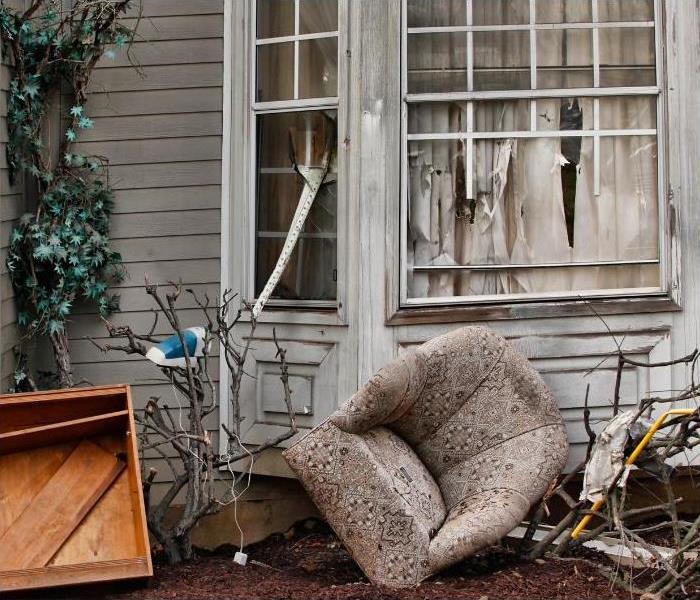6 Steps to Recovery After A Storm Damages Your Rental Property
6/14/2021 (Permalink)
Storm damage to a rental property is a landlord's worst nightmare.
It is hard enough to deal with storm damage on your property, but what about storm damage to the rental property you own? Whether it was a tornado or hurricane that caused the storm damage, there are steps to take to ensure you and your tenants recover quickly. This blog post will give you six simple steps that will help your property recover after being damaged by storms.
The responsibility of the landlord
Storm damage to a rental property will likely occur when the property is in an area at high risk for storm damage. The team at SERVPRO of East Dayton/Beavercreek knows that landlords are at greater risk for Dayton tornado damage. Therefore, before the next tornado passes, it is a good idea to go over tornado preparation tips with your tenants.
When a tornado passes and causes storm damage to a rental property, a Dayton landlord must be mindful and courteous to their tenants and repair storm damage immediately. If the damage has made the property uninhabitable, it may be the landlord's responsibility to provide temporary housing for their tenants, depending on the lease agreement.
6 Steps to recovery
- Communicate with your tenants
- Contact your insurance company
- Keep track of damaged contents
- Get the damages professionally assessed
- Prevent further damages
- Restore the property
1) Communicate with your tenants
After a storm passes the area of your property, you need to be in communication with your tenants and check if they are safe, and then ask about property damages. The extent of the storm damage to a rental property may be uninhabitable and require temporary housing, which can be reimbursed through renters insurance or the American Red Cross.
Your tenants are counting on your support; it would be a good idea to advise them to contact their rental insurance company immediately.
2) Contact your homeowner's insurance company
Whenever there is storm damage to a rental property, we recommend that the property owners contact their homeowner's insurance company ASAP to let them know what happened. Your homeowner's insurance company will advise you on how you should move forward.
If you live in your rented property, the storm damage to the rental property may be "unfit to live in," and you will receive a reimbursement for temporary housing. A homeowners adjuster will determine if a home is unsafe after a severe storm on a case-by-case basis.
3) Keep track of all damages
When your property is safe to enter, it is essential to track an accurate list of your losses. You can create a list on Google Sheets or Microsoft Excel. While creating the list of damages, you should also be taking pictures and videos for insurance claim proof. A list that tracks storm damage to a rental property needs to include the following:
- Structural damages
- Damaged electronics
- Damaged furniture
- Damages cabinets
- Damaged flooring
- Broken windows
- Roof damage
- Wall water damage
- Ceiling water damage
- Standing water
- Signs of mold damage
4) Get the damages professionally assessed
After communicating with your tenant and ensuring that they are safe, you need to have a professional team come out to assess the storm damages to the rental property. We suggest assessing the property even when there aren't any apparent damages because storm damages to a roof are sometimes not noticeable until months after the damages occurred.
5) Prevent further damages
Securing the property is the best way to prevent additional storm damage to a rental property after a storm passes. You can secure a rental property by covering open holes in the roof or walls with plastic sheeting.
6) Restore the property
After storm damage to a rental property occurs, you will want your property to be restored by a reputable restoration company. Water damage to a rental property will require mitigation services to dry out the property. Once the property is dry, the rental property may need new drywall, insulation, and paint.
Contact SERVPRO for storm damage services.
The professionals at SERVPRO of East Dayton/Beavercreek have seen it all when it comes to emergency damages, and storm damage to a rental property is no exception! When you contact our Dayton storm damage team, you will quickly have a team of IICRC certified professionals that take pride in delivering quality work.
We have over sixty years of experience working with insurance claims and are ready to help you get a fair amount on your rental property insurance claim. From exterior to interior damage, we understand no repairs can wait. Contact us today for any further questions or emergency services regarding rental property storm damage.



 24/7 Emergency Service
24/7 Emergency Service